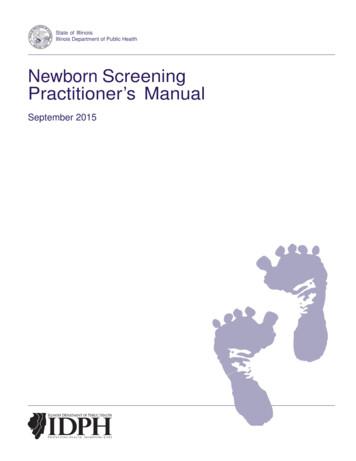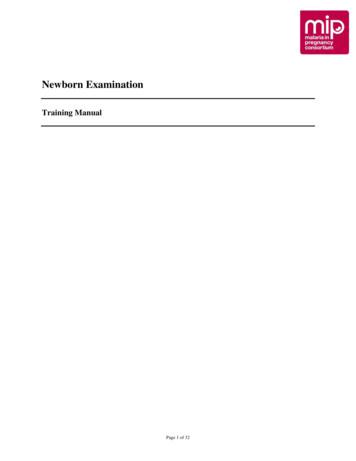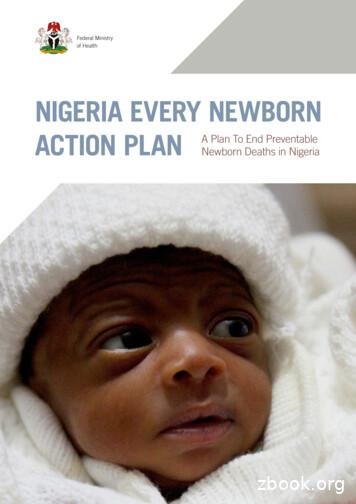Newborn Screening And Follow-up Of Children With Endocrine Disorders .
Newborn screening and follow-up of childrenwith endocrine disorders:current successes and challengesDavid Allen, MDProfessor, Division Chief, and Fellowship Program DirectorDepartment of PediatricsUniversity of Wisconsin School of Medicine and Public Health
Wisconsin Newborn Screening (NBS) PanelHemoglobinopathies (5) Beta Thalassemia MajorHemoglobin S-Beta ThalassemiaHemoglobin SC DiseaseHemoglobin E-Beta ThalassemiaSickle Cell DiseaseOrganic Acidemia (12) Example: Proponic AcidemiaOther Disorders (5)Biotinidase DeficiencyGalactosemiaCystic FibrosisSevere Combined Immune Deficiency(SCID) Spinal Muscle Atrophy (SMA) Fatty Acid Oxidation Disorders (12) Medium Chain Acyl-CoA Dehydogenase Deficiency (MCAD)Amino Acid Disorders (11) Example: Phenylketonuria (PKU)Endocrine Disorders (2) Congenital Adrenal Hyperplasia Congenital Hypothyroidism
NBS for CH in WisconsinCongenital hypothyroidism 1:2000 live births ( 35/year WI) Most common preventable causeof cognitive disability NBS – TSH predominant Continuum of severity –permanence established by 3y Therapeutic objective – FT4 uppernormal, TSH lower normal Follow-up – Lab q3-6 months Frequent dose adjustment Ped Endo visit 1-2 x/year Telemedicine adaptableAll InfantsTSH Measurement(Immunoreaction Assay)NBS TestTSH belowspecimencollection agespecific cutoffTSH abovespecimencollection agespecific cutoffCH ScreenedNegativeInfantsCH ScreenedPositive InfantsConfirmatory Test Endo consultationSerum TSH and T4Confirmed CH InfantsCH Screened FalsePositive Infants
NBS for CAH in WisconsinCongenital Adrenal Hyperplasia (21OHD ) AR, 1:10,000-15,000 births Cortisol aldosterone deficiency,female genital and CNS virilization Pre-NBS - salt-wasting adrenal crises,17-OHP belowsex mis-assignmentbirth weightspecific cutoff NBS – filter paper 17OHP High false positive - second tierCAH Screenedstrategies evolvingNegativeInfants Treatment – cortisol andmineralocorticoid replacement Follow-up Lab, PE, growth monitor q3-6m Frequent stress-dosemanagement for illness/injury Puberty – complex psychosexualand medical managementAll InfantsNBS Test17-OHP Measurement(Immunoreaction Assay)17-OHP abovebirth weightspecific cutoffSteroid Profile(MS/MS Assay)CAH ScreenedPositive InfantsEndo consultationSerum 17-OHPSerum ElectrolytesConfirmed CAHInfantsNBS TestConfirmatory TestCAH ScreenedFalse Positive Infants
Specialty care for children with CH and CAH:shortage and maldistribution of pediatric endocrinologists Ten states have fewer than 1 PE per 100 000 children
Dwindling recruitment: Total PE fellows declined from 254 (2012) to 243 (2018) Applicant/position 0.7 - 41/108 positions unfilled (2020)
Declining recruitment to Pediatric Endocrinology
Dwindling recruitment: Total PE fellows declined from 254 (2012) to 243 (2018) Applicant/position 0.7 - 41/108 positions unfilled (2020)Declining and under-diverse current workforce Aging - 21% 60 years old Early career – 80% female (many part-time) URM 23% of trainees, 5.5% blackGrowing patient population Increasing T1DM and (especially) T2DM and obesity-morbidity Transgender, cancer survivors, retained complex young adult ptsSynchronous trends— fellowship recruitment, patient numbers - shortage of trained pediatric endocrinologists
Lack of early subspecialty exposure and mentorship Not required medical school rotation Typical 3rd year residency exposure post-career decisionFinancial concerns Medical student debt (averaging 232K) dissuades additional training Relatively low average salary of PENegative professional QOL perceptions Personal/professional life boundaries perceived unpredictable for PE Competition from shift-scheduled specialties (e.g. hospitalist)
Lifetimeearnings ofpediatricspecialistscompared togeneralpediatricians - 1.5 million lifetime earnings
Pediatricendocrinology:largest relativedecline inlifetime earningsamong pediatricspecialists2007 - 2018
Lifetime earningpotentialpredicts: distance tosubspecialists # subspecialists perregional pediatricpopulation increase in #specialists/populationgrowth fill rates for fellowshiptraining spots
Increase early positive exposure to Pediatric Endocrinology Outpatient subspecialty exposure in core rotations Emphasize exposure to enthusiastic fellow and facultymentors ACGME/CoPS/APPD support for early residencyexposure to nonprocedural subspecialties Professional society medical student recruitmentinitiatives
Lessening barriers Financial Expand loan forgiveness for work in underserved areas and lower-paidspecialties Fund a targeted Loan Repayment Program for non-procedural specialties Implement shared-care models that value non-procedural PE expertise Duration of training Re-evaluate 2 year program and modify if deemed appropriate Perceived lifestyle detractors Expand utilization of care extenders Embrace technology to improve work/personal life balance
Pediatrics 2025: AMSPDC Workforce InitiativeObjective: attract trainees toundersubscribed pediatric subspecialties: Change medical education paradigm Early exposure and marketing Address economics Lessen financial burden Equalize Medicare and Medicaidrevenue streams Equalize compensation
Steps to ensure follow-up for endocrine disorder NBS Early life close collaboration with NBS program Recruitment to strengthen viability of the PE specialty Assistance from care extenders (PA, NPP) Effective for CH CAH Private practice academic institutions Adult medicine collaboration/early transition Limited necessity for CH CAH transition complicated and thus far not satisfactory Technology (propelled forward by COVID-19) Improves patient access ( 50% CH follow-up visits) Does not address provider shortage
Thank you for this opportunity to presentWISCONSIN STATE LABORATORY OF HYGIENE - UNIVERSITY OF WISCONSIN
Fatty Acid Oxidation Disorders (12) Medium Chain Acyl-CoA Dehydogenase Deficiency (MCAD) Endocrine Disorders (2) . Amino Acid Disorders (11) Example: Phenylketonuria (PKU) Wisconsin Newborn Screening (NBS) Panel. Organic Acidemia (12) Example: Proponic Acidemia. NBS for CH in Wisconsin. All Infants. TSH below specimen collection age .
A Guide for Newborn Care Providers. Table of contents Section 1 Background information 1.1 Introduction 1.2 NSO history 1.3 NSO contact information 1.4 Newborn screening essentials 1.5 Newborn screening timeline 1.6 Newborn screening results 1.7 List of disorders included in the NSO screening panel
Practitioner's Newborn Screening Responsibilities 7 . Specimen Collection 7 . . a notice that a child in their care has a serious abnormal newborn screen, or has been diagnosed with a newborn . health care professionals as a reference guide to newborn screening in Illinois. This resource provides protocols
P007 Newborn affected by oth medical procedures on mother, NEC P0081 Newborn affected by periodontal disease in mother P0089 Newborn affected by oth maternal conditions P009 Newborn affected by unsp maternal condition P010 Newborn (suspected to be) affected by incompetent cervix P011 Newborn (suspected to be) affected by premature ROMFile Size: 1MB
Newborn examination . As part of this project, you will be conducting a newborn examination. All births (both live and still births) that occur within the study will need to have a newborn exam completed. A newborn examination has many purposes including: It allows us to quickly identify certain problems the baby may have been born with, and
1.1 Development of the Nigeria Every Newborn Action Plan 6 1.2 Overview of the Nigeria Every Newborn Action Plan 6 1.3 The Global Picture 7 2.0 The State of Nigeria's Newborns 8 2.1 Newborn Mortality Trends and Disparities 8 2.2 Causes of Neonatal Mortality 9 2.3 Stillbirths 10 2.4 The Maternal and Newborn Health Continuum of Care 10
Newborn Care: A Guide to the First Six Weeks Facilitator’s Guide 2013 InJoy Productions, Inc. Permission to copy granted. 2 Introduction (0:59) a. Parenting a newborn may seem mysterious at first, but with time and experience, new parents will learn how to best care for their baby 1. Your Newborn (3:09) a. Newborn Appearances – baby’s .
4.4 Emerging and re-emerging infections 43 4.5 Clinically insignificant transfusion-transmissible infections 44 5 Blood screening, quarantine and release 45 5.1 Blood screening process 45 5.2 Approaches to blood screening 45 5.3 Pooling for serological assays 47 5.4 Sequential screening 47 5.5 Blood screening and diagnostic testing 48 5.6 Emergency screening 48 5.7 Screening plasma for .
Policy Area 5: Decision-making process 3 Introduction 4 Guiding principles 4 Background 5 Newborn bloodspot screening is complex 5 . 3.2 Health professionals who support and deliver newborn bloodspot screening take action to promote quality and safety. 3.3 Facilities, equipment and work processes are designed for quality and safety. .























